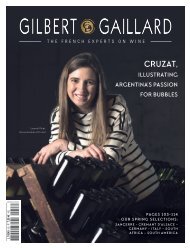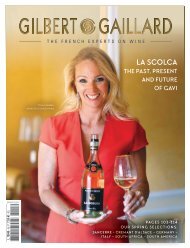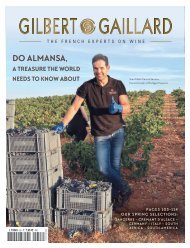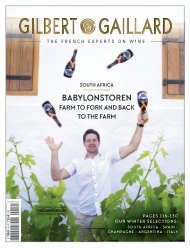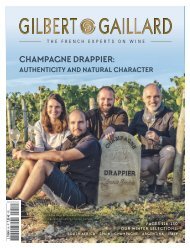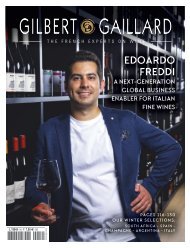FRA_GG_N46-WEB
The GILBERT & GAILLARD International Magazine : Make some room in your lounge for WINE REGIONS from around the world
The GILBERT & GAILLARD International Magazine :
Make some room in your lounge for WINE REGIONS from around the world
You also want an ePaper? Increase the reach of your titles
YUMPU automatically turns print PDFs into web optimized ePapers that Google loves.
CHAMPAGNE<br />
– STYLES –<br />
Besserat de Bellefon in the centre of Epernay, beyond<br />
the Avenue de Champagne<br />
its wines are blends of juice from different villages in<br />
Champagne. A very small number of labels, like the<br />
Vieilles Vignes Françaises or the Côte aux Enfants,<br />
a non-sparkling Pinot noir produced in the Coteaux<br />
Champenois area, are single-vineyard selections. But<br />
there is now an intermediary version – a single varietal<br />
Pinot noir blended from several vintages, but where the<br />
main growth is a village selected every year. The village<br />
is stated on the label, for those who can decipher it!<br />
‘PNVZ15’ means that the majority 2015 wine came from<br />
the village of Verzenay. This was also true of PNVZ16,<br />
with wine from the following year. But for the 2017s, the<br />
label still states PNXX17, because the choice of village<br />
has yet to be announced. Are these the first stages in a<br />
move towards a 100% single-vineyard wine? “Maybe”,<br />
smiles Bunner.<br />
Nathalie Doucet, chair of Champagne Besserat de Bellefon<br />
14 WINTER 2021 GILBERT & GAILLARD - THE FRENCH EXPERTS ON WINE<br />
BESSERAT DE BELLEFON: QUALITY BUBBLES<br />
This old house, established in 1843, has belonged to<br />
the Lanson group since the 1990s and is now based in<br />
Epernay. Fifteen to twenty percent of the wines come<br />
from their own vineyards, with a balance stemming from<br />
supply contracts.<br />
Cédric Thiébault, the cellar master, has been with the<br />
house since 1999. First of all, he explains that the<br />
‘Besserat de Bellefon feel’ has now been extended to all of<br />
their labels. So what does it entail? Having a Champagne<br />
that looks creamy when you pour it into a flute glass,<br />
instilling greater lightness and silky mousse. How is it<br />
created? By deliberately reducing effervescence to around<br />
4.5 to 4.8 bar, when most Champagnes are around 5.5<br />
to 6 bar. The Champagne appellation does, indeed, allow<br />
producers to reduce pressure to as low as 3 or 3.5 bar.<br />
For lower pressure, less bottling liquor or ‘liqueur de tirage’<br />
must be used during the secondary fermentation. The<br />
idea arose in 1930 as part of a process to producer lighter<br />
Champagne that could pair with an entire meal. Less gas<br />
does indeed lead to finer bubbles, as demonstrated by the<br />
scientist Gérard Liger-Belair. At Besserat de Bellefon, this<br />
technique was first reserved for the Cuvée des Moines,<br />
but has now been applied generally across the range.<br />
Similarly, the special shape of the bottle for this label has<br />
now been rolled out for the entire portfolio.<br />
Continue on page 16



